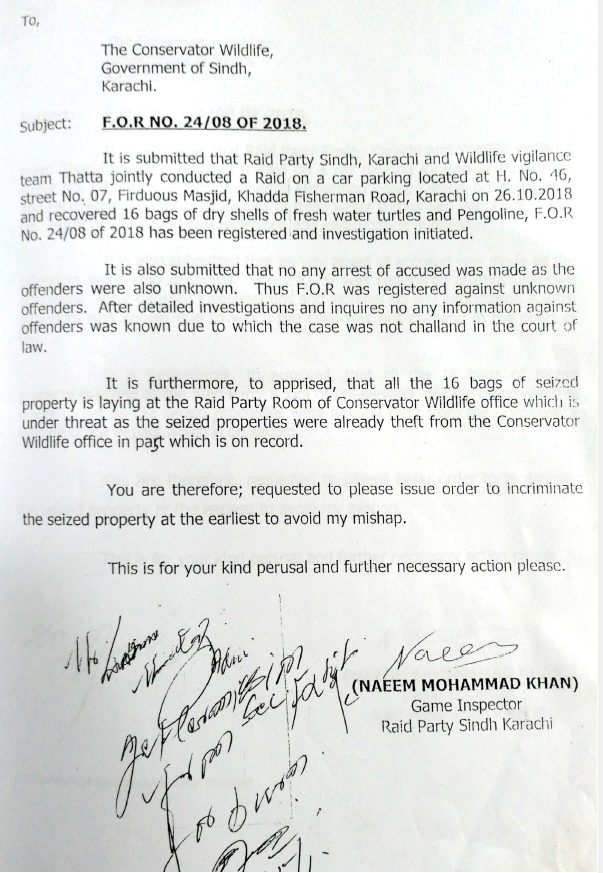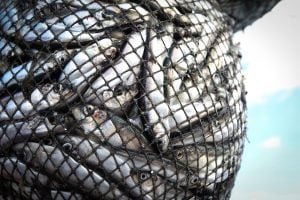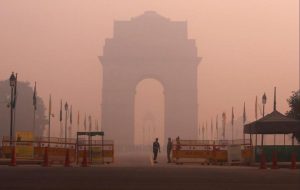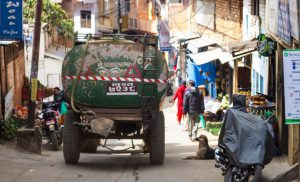“The pangolin is killed because of its scales, which are its enemy. [The scales are] used in traditional Chinese medicines, thus, it is being smuggled from the province [for sale in China]” said Javed Ahmed Mahar, conservator at the Sindh Wildlife Department. The scales are made out of keratin, the same substance as that of human fingernails. Mahar said that some were so strong they are used to make crude bulletproof jackets as well.
See: The plight of the pangolin in China
In the past the pangolin, also known as the scaly anteater, lived across the forests of the province. But since the colonial, period Sindh has been turning its forests into farmlands. This slow transformation over the last century and a half has turned Sindh into the province with the best irrigation system in Pakistan, but 80% of its forests have disappeared. As a result, the pangolin population has moved to the less irrigated muddy areas of Koh-e-Sulaiman in western Sindh, bordering Balochistan. Mahar estimated that only 5% of Pakistan’s pangolin population now remained in Sindh, with the rest in Punjab and Kashmir.
One of the challenges of dealing with the shy mammal is that there are very few estimates of its number. There are eight species of pangolin across the world, and one, the Indian pangolin, is indigenous to Pakistan as well. The International Union for Conservation of Nature (IUCN) notes, “There is virtually no information available on population levels of any species of the Asian pangolin. There is a lack of research on population densities and on local, national and global populations.”
It goes on to state that, “In Pakistan, research in the last three years into the ecology of this species in the Potohar Plateau, Punjab province, has documented rapid population declines locally as a result of illegal killing to obtain scales for international trade.”
Sometimes the creature is killed simply because it looks strange. Ghulam Sarwar Jamali, a former official of the Sindh Wildlife Department, said that people react in fear to the sight of the pangolin, given its unusual shape and scaly skin, and often attack it. “It is harmless for the people, but they think it will attack them,” he said.
In a study, one of the very few conducted in Pakistan, respondents in Kashmir expressed an unreasoning fear of the mammal. Of the 268 interviewed, “86% respondents thought that Indian pangolins excavate graves and feed on human dead bodies.” As a result, most respondents would try and kill the creature if they found it in the forest, due to the misperception that they pose a danger to humans.
Pangolin trade
The far graver threat, though, is poaching for the smuggling of its parts to China. In October 2018, Sindh Wildlife Department teams raided an area of the port city of Karachi and seized 16 bags filled with pangolin scales.
One person close to the trade said that pangolin scales fetched USD 3,000 per 20 kg in the Chinese market, more than the annual average income. This makes it hard to enforce laws designed to stop the illegal trade. About 80% of the scales captured during the raid never reached the department, disappearing en route, and the rest were stolen from the custody of the department along with other evidence, said Mahar.

However, the courts have never initiated any inquiry into the disappearance of the pangolin parts, no one has ever been prosecuted for the theft, and the department officials from whose custody the scales and other goods were stolen have escaped any censure.
The work of the forest department is also hampered by the fact that wildlife departments in Pakistan are overwhelmed. The Sindh Wildlife Department has sole responsibility for protection and conservation of local as well as migratory animals and birds in the province, but they do not have the resources to manage this, “Funds are not enough even for wildlife conservation,” said one official.
As a result the department does not carry out any survey of the fauna it is supposed to be protecting, whether the pangolin or any other animal. Small-scale surveys are being conducted only on migratory birds, said the official. Without such data the department is completely dependent on anecdotal knowledge when it comes to the distribution of the animals, their number, and the level of their decline.
Demand for pangolin scales driven by China
Some officials say that pangolin meat is being sold in the local market, as people coming from China like it. A large number of Chinese people are staying in Karachi, working on projects related to the China Pakistan Economic Corridor (CPEC). But these allegations have never been formally investigated or proven.
International concern over the pangolin, the most trafficked animal in the world, is revealing new data about trafficking of pangolin parts, even if the government departments are still slow to act. WWF Pakistan recently conducted a detailed survey whose draft was shared with the author on pangolins in the country. The survey was conducted in animal markets to assess the scale of pangolin trade from different cities in Pakistan (Lahore, Peshawar, Rawalpindi/Islamabad and Muzaffarabad), and the route and processes through which they were trafficked.
The WWF surveyed 239 shops, including bird and pet stores, herbalists, street vendors from Rawalpindi, Lahore, Peshawar, Muzaffarabad and Karachi. “It was observed that all were involved in the illegal trade of all species of wildlife, including Indian pangolins, and other CITES listed species. Derivatives of mammals, reptiles, birds, and invertebrates are being sold by street vendors and herbalists. These medicines are commonly sold in the form of powder and ointments and used to cure muscular and joint pain and are believed to have aphrodisiac properties,” the report said.
Karachi and Lahore hosted the highest numbers of shops dealing in illegal wildlife trade followed by Rawalpindi, Peshawar and Muzaffarabad. Airports in Lahore, Karachi, and Rawalpindi are critical to the international pangolin trade. The China and Afghanistan borders are also highly strategic places where there is high potential for this trade. So far, though, limited surveillance has meant that there is no evidence whether these borders are being used for this purpose.
Riaz Hussain, a wildlife zoologist and a member of the IUCN Special Survival Commission Pangolin Special Group, said, “Massive smuggling of pangolins has been recorded from Kashmir and Punjab to China. We got cases registered against 50 such people involved in the smuggling.” Whether it was due to this, or other factors, smuggling has gone down a bit in Punjab in recent years.
Hussain, who is also Chairman Zoology Department, Horizon Postgraduate College Chakwal, said that there was no government protection of the pangolin in Pakistan. “In October 2018, a meeting was held at the Ministry of Environment to look at this matter and a draft was prepared, but no follow up meeting was held.” He said that practically no action has been taken.
But before the big challenges are dealt with, the public perception of the animal has to change. A few years ago a local Sindhi newspaper, Kawish, ran a story that a dangerous animal was caught by people. The animal photographed was a pangolin.
Abdul Ghaffar Bhutto, a teacher of zoology, wrote to the editor of that newspaper to complain, explaining that the pangolin is an innocent anteater. There needs to be a better understanding of the animal and its plight both among the general public but also among the media, Bhutto said, with its portrayal as a dangerous animal putting it in further jeopardy.
![<p>The Indian pangolin is slowly disappearing from Pakistan [image by: Ansar Khan / Life Line for Nature Society]</p>](https://dialogue.earth/content/uploads/2019/05/indian-pangolin.jpg)







